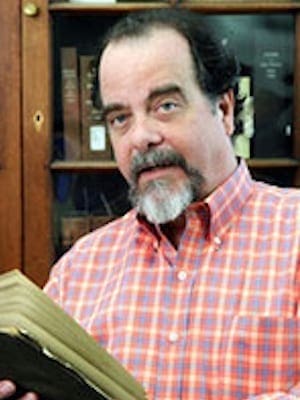Mention of Harry Emerson Fosdick usually brings to mind his very public role in the fundamentalist-modernist controversy that rattled Protestant America early in the 1920s.
In 1918 Fosdick accepted the position as preaching minister at the First Presbyterian Church of New York City, a new church formed through the merger of three congregations.
He was at the time a life-long Baptist and a member of the faculty of New York’s Union Theological Seminary. Fosdick’s powerful preaching skills had been honed in Baptist pastorates in New Jersey and New York, and now he was the Baptist preacher in a Presbyterian pulpit who would define the clash between fundamentalism and modernism in the early 20th century.
By the time Fosdick first mounted the pulpit at the First Presbyterian Church the cauldron of controversy already was nearing a boiling point. Fosdick’s fame–and the following he was getting–brought him under the scrutiny of conservative Presbyterian scholars and ministers. Two years before the appointment to First Presbyterian, Princeton scholastic J. Gresham Machen said of Fosdick’s preaching: “[H]e is dreadful! Just the pitiful modern stuff about an undogmatic Christianity.”
In 1922 the cauldron boiled over and Fosdick was badly burned, but it took three years for the blisters to form. Early in the year William Jennings Bryan, who in 1925 would be the prosecutor at the Scope’s Trial in Tennessee, published a piece in The New York Times, “God and Evolution.” Editors at The Times asked Fosdick to respond to Jennings. The rebuttal was scathing and considered by some a call to arms against the political designs of fundamentalism.
Two months later, on May 21, Fosdick preached his most famous sermon, “Shall the Fundamentalists Win?” The sermon was a calculated assault upon what Fosdick called an attempt to “drive out from the Christian churches all the consecrated souls who do not agree with [fundamentalists’] theory of inspiration.”
Fosdick’s sermon was widely distributed among Protestant ministers in America and prominently published in places such as The Christian Century.
Also in 1922, Fosdick delivered the Cole Lectures at Vanderbilt University’s School of Divinity. The six lectures were published under the title, Christianity and Progress.
By year’s end the forces opposed to Fosdick and his theology were growing. Many Baptists who did not care for Fosdick’s brand of progressive theology joined the cries of conservative Presbyterians who wanted Fosdick out of the pulpit of the prominent New York church. At the same time the ranks of Fosdick’s supporters were swelling, too.
The cauldron, indeed, boiled over. Fosdick was scrutinized and hounded by his opponents, and supported and celebrated by those eager for him to carry the banner of theological modernism. After rancorous meetings of the General Assembly of the Presbyterian Church in 1923 and 1924 and the continuing distractions that found a way out of the internecine conflicts of Presbyterians and Baptists, Fosdick in 1925 agreed to assume the pastorate of the Park Avenue Baptist Church, with some stipulations.
Fosdick was initially not interested in leading the church. Three things in particular concerned him.
First, he regarded the baptism policy of the church restrictive. Fosdick believed that the gospel extended a welcome to all who desired to become followers of Jesus. Demanding a particular mode of baptism, Fosdick believed, restricted the breadth of God’s welcome.
Second, Fosdick was troubled by the affluence of the congregation and their Park Avenue address. He urged the church to agree to move to a new location.
Finally, Fosdick had had enough of denominational politics. He wanted to lead an interdenominational church where the proclamation of the gospel included good preaching–which he would deliver–and conscience-driven social action.
Through the largesse of John D. Rockefeller, Jr. (and others) and the commitments of the membership of the Park Avenue Baptist Church, Fosdick realized his dream. Riverside Church was built in the Morningside Heights area of New York City. Early in 1931 the new church was dedicated and for the first time the strains of Fosdick’s magnificent hymn, “God of Grace and God of Glory,” rang out:
God of grace and God of glory,
On thy people pour thy power;
Crown thine ancient Church’s story;
Bring her bud to glorious flower.
Grant us wisdom, grant us courage,
For the facing of this hour.
Fosdick had survived the denominational and cultural wars of the 1920s, but he was not done with his work as a prophet.
Just over a dozen years after Fosdick joined the fray of political theology with his “Shall the Fundamentalists Win?” sermon, in 1935 he delivered his second-most famous sermon: “The Church Must Go Beyond Modernism.”
There is a common thread that runs between the two sermons and, indeed, throughout the remarkable life of Harry Emerson Fosdick. Each sermon decries any attempt to bind to the church to a particular period of history.
Fosdick’s resistance to fundamentalism was rooted in his conviction that a wooden agreement with the past robs the church of its present. His resistance to modernism was rooted in his conviction that an unquestioning agreement with the present status of science and culture robs the church of its future.
The “facing of this hour” for Fosdick always required a creative tension between what was and what could be. It is, in a word, the tension of the gospel.
Richard Wilson is professor of theology and chair of the Roberts Department of Christianity at Mercer University in Macon, Ga.

